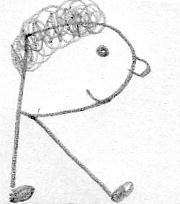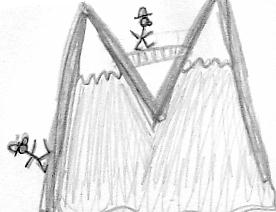
Recently I’ve been trying to teach my two and a half year old child to learn some letters from the alphabet. I want him to learn to write his name, and at least recognize all the letters of the alphabet. I figure this is not too early for him as he is really into drawing and “reading” books and even pretending he is reading the letters. So everyday I sit with him at the table, like a big boy, and we do “school work” for about 1/2 an hour. It’s fun for him, because he thinks he’s like my older two sons, doing his homework. It’s mostly fun stuff we do anyway, and he has no clue that he is “learning” anything. For him it’s just quality fun time with his mom; for me it’s also quality one on one time with him, but also the sooner he learns the alphabet, the sooner he’ll be ready to start reading and therefore the sooner he’ll be an independent learner.
But let’s get back to how I actually teach him letters (and I did do this for my two older boys at around the same age: around 2 to 3 years old). Here are some tips I picked up from various places and just my own experience how best to teach really young kids to write / recognize letters:
1. Make the letters come alive. This means that the letters must have meaning for the kids, otherwise they are just some random lines or scribbles. For instance, one of my children’s name is Robert, so I wanted him to learn the letter R. So whenever I drew it for him I made it into a person walking… specifically him. I would say: “This is your head, and your two legs, see, you’re walking?” I would sometimes add an eye, nose and mouth in profile, and some feet. I wouldn’t add arms, as this would most likely confuse him – I wanted to keep the integrity of the letter. I also would make it a story while drawing the letter. After many times / days of doing this, I would ask him to participate in the story of drawing the letter R, but with me still drawing it for him: “OK Robert, let’s draw your letter, the letter R. What do I do first?” The final step is of course for the child to practice drawing the letter on his own. But this shouldn’t require too much pushing. Kids usually love to draw, and if they’ve practiced enough with them, they’ll know how to draw it, so they won’t be intimidated by the task. To push them at first, you might want to start by drawing the letter for them (making them tell you how to draw it), then asking them to do it after: “Now it’s your turn.”

At first the drawings of the letters will be very crude and almost unrecognizable. But praise them nonetheless. Every piece of encouragement will make them continue, and practice is of course how they will get better. Sometimes I would use this technique for older children that have trouble with associating sounds and letters together. I would find a word that looks like the letter and starts with it also. For instance, this kid in grade 1 had a really hard time remembering that the letter M sounds like MMMM. So I drew him the letter M, then started drawing snow capped on the two “mountains’ of the M, then I drew a bridge from one “mountain top” to the other. As I did this, I was telling him the story and making sure I repeated that this is an M for Mountain. Every time I saw the kid for the next week, I would ask him to draw an M for me, or I would draw him and M and ask him what sound that makes. After a short short time, he had that letter memorized (sound + symbol).
Kids really need to see the letter as a picture initially. Later, it’ll be second nature, but in order to get over the hump of remembering the association of symbol to sound, making the letters come alive is the best strategy I came across.
2. Tracing your pencil drawn letters with markers. This is good for just the “drawing” part, to practice the child’s fine motor skills and letter writing. In front of my child, sitting beside him, I draw a nice big letter (not too big, but big enough for the child to trace with the marker), whatever letter I want to practice. I then give him a choice of markers, and he chooses his colour. To start off, I also choose a marker and trace my own letter with the marker. Of course once the child knows the game, I don’t have to trace my letters, because he knows what to do. So whatever i draw, he traces. This works really well at the very very beginning of writing. And since I’m right there with him praising his technique and only rarely telling him what to improve on, he loves this game, and wants to do it over and over again. This practice is exactly what I aim for.
3. Use sticks / pens / chopsticks to make the shapes of letters. Sometimes children’s fine motor skills are still not good enough to make nice letters. So instead I use sticks to construct letters. I take crayons, pencils, forks, branches, or whatever “sticks” I can find close by, and make shapes of letters. The letter A is an awesome one. I like to teach A and H at the same time, because you can make an A and then transform it into H with just a small move of the sticks. This makes the child think and analyze the letter shape. They see the comparison between the two letters, and this makes them see how each letter is formed and how it’s different from the other. The kids love this also, because it’s building. Also, they can do it anywhere – at the park, in a restaurant, at home with the crayons, at the kitchen table, etc. Plus children don’t have to use their fine motor skills with this game, which sometimes develop later than their cognitive capacities.
4. Choose only a few letters to practice at a time. Make sure to teach your child only a few letters at a time (maybe two or three). Start with the easy ones, that are really recognizable (like O and i), or the important ones, like the ones in your child’s name. If you do too many at a time, then the child won’t learn – the task becomes too complex and the child will give up before mastering even one letter. Let your child master just a few letters before going on to the next bunch. I recommend two or three, so that there is comparison and variety. For instance, you can ask your child: “Find the A” but if you’re only learning A’s then you would only have A’s on the page. But let’s say you’re teaching the child the letter A, R and K, you would have all of those letters on the page and then, when you ask where is the A, it’s actually something the child has to think about. The child then can analyze the shapes and learn / internalize the letter shape from this analysis. If you are super organized, you could have the “letters of the week” idea going. Put them up on your fridge or in the kid’s room and have the kids see them all the time. But keep on practicing the same letters until they are mastered by your child.
5. Flashcards. Once the child learns a few letters (like 10 or 12), make some flashcards with them, and once a day (maybe with breakfast or lunch) practice all of them – sound and symbol. This will review all the letters that they learned up to now, and not let them forget. Make it a habit, but also make it fun, so that it’s a game for the kids. I made my flashcards from old cereal boxes. All I did was cut up the boxes into small squares, and wrote each letter on the back (the brown part) of the card. Then I put all of these in a bowl and kept the bowl near the dining table. With every meal we would practice all the letters. I’m not at this stage yet with my youngest one, but when my other two were there, the flashcards worked wonders. I even had flashcards with simple words for my oldest and just letters for my second child. Both had to answer their own card in turn, but they were never in competition, so this worked great (no fighting).
6. Practice makes perfect. Of course, teaching and learning is an ongoing process. The more exposure my children have to anything, the more ingrained it becomes in their little brains. So once you establish what letter you are teaching at a given time, make sure you make the child notice it all the time, everywhere: at the store, on the street, in the playground, etc. My youngest son is learning the letter A, H, K, O and i right now. He loves the letter A. Wherever he goes, he notices the letter, and always tells me. Encourage this type of behavior, and even ask them to find the letters in stores, in books, on street signs etc. Even at the playground, ask your child to draw the letters in the sand. But you need to be in tune with what they are capable of. Don’t get them frustrated, because this will turn them off, and it’ll be doubly hard to make if fun again. Don’t push, but practice in a fun way – a way that will make them feel so much smarter and part of the human culture.

